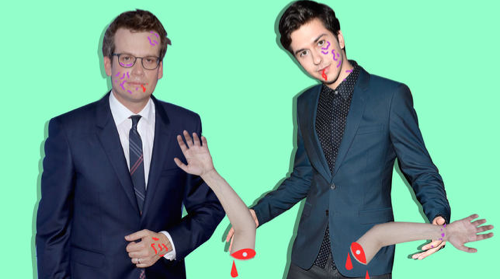What makes people feel the need to
call something a monster? Fundamentally, we humans are afraid of
things we can't understand. But monster is a fairly broad, open-ended
term. For instance, we sometimes use the word monster to describe
something like bigfoot, a massive humanoid creature, but also to
describe microscopic organisms that terrorize their prey in a much
different way than the brute force of bigfoot. Sometimes, we even
call other humans monsters for their actions. So what then, defines a
monster? Essentially, a monster is any thing that looks or behaves in
a way we find frightening or don't understand. For the purpose of
this paper, I will stick to discussing two types of monsters:
mythical and natural.
Mythical monsters always make for a
great discussion. Bigfoot, Yeti, the Loch Ness Monster, are names we
are all familiar with and always seem to pop up in this field. These
mythical creatures share a few things in common; they are large,
solitary animals that plenty of people claim to have seen, yet there
is no real proof that any of them exist , or ever did. So where did
these come from? Well, creating this type of monster may actually be
quite easy. In fact, you only need one person to confirm the
existence of a monster. They can give a general description of its
size and other physical characteristics, that other people then hear
and visualize themselves. While trying to decide what exactly I
defined a monster as, I read a National Geographic article, which had
a section discussing that we as humans are “notoriously bad
witnesses”. Basically, this means that not only does our vision
often play tricks on us, but our memory can also distort what we
thought we saw. These two in combination with us can turn a
questionable grizzly bear sighting into a confirmed Sasquatch
spotting. Again, this ties in to our human nature to want to
rationalize things so we go from “I have no clue what that rustling
noise outside my tent is” to “it must be bigfoot!” In reality,
the jump isn't quite that drastic (hopefully), but the underlying
principle holds true. So, based on these human tendencies, combined
with a lack of solid evidence of these creatures, we can pretty much
rule out any real possibility of their existence.
When we think about monsters, we are
naturally inclined to think of the big bad ones, but some natural
monsters here on our own earth can be just as interesting, if not
more. Our world is teeming with natural monsters: parasites, viruses,
and many other crazy plants, animals, and fungi. But we have
certainly proven these things to exist, so does that mean they aren't
monsters? Quite the opposite actually, they just take on a different
meaning to the word. Although we can observe them in everyday life,
their actions are what really creep us out. For example, in class, we
discussed monsters that would essentially take over a host organism,
such as the wasp and the cockroach, and use its body to promote its
own survival. Again, this fear comes from our own human nature,
because this kind of parasitic relationship isn't a concept that is
familiar to humans, so we look as disturbing and grotesque. However,
these creatures behave in this way because it is instinctive to them;
everything they do is because of pre-encoded instructions in their
DNA. Still, they do create some pretty bizarre situations, like rats
that aren't afraid of cats, or caterpillars that protect the maggots
that just devoured and crawled out of its own body. So, we can assume
that these “monsters” are in fact real and living among us.
So what can we take away from this?
How is it possible that imaginary beasts and real organisms can both
be called monsters? Quite simply, it is because the term monster is a
very abstract one. The common theme here is one of fear: mythical
monsters are scary because of their size and brutish actions, whereas
natural monsters are more fearsome for the way they manipulate their
prey to carry out their will. Monsters can help us learn more about
ourselves, such as what makes us feel fear. They can also peak our
curiosity in hunting for them. Overall, Monsters Are Useful!
Link to Article: http://news.nationalgeographic.com/news/2013/09/130907-cryptid-crytozoology-bigfoot-loch-yeti-monster-abominable-science/
